|
Native Tree Society Expertise
The expertise of an organization is not only reflected in the
credentials of its officers and members, but in the accomplishments of
the organization as a whole, and the contributions made by its regular
members. The Native Tree Society has strength in all of these
areas. Under the original ENTS we became known as the foremost
tree measuring group of the eastern forests. One website described
us a "tree measuring fanatics." Rather than taking that as an
negative approbation, we consider it a compliment.
Dendromorphometry, represents our most successful NTS achievement.
Sine-based tree height measuring, Rucker Indexing, and trunk-limb volume
modeling have filled real needs, though largely unperceived by forest
professionals.
 We
have added unprecedented tree dimension accuracy and have contributed
enhanced site descriptions for many forest icons to include superb
forest sites like the Great Smoky Mountains National Park, Cook Forest
State Park, PA, Zoar Valley, NY, and Mohawk Trail State Forest, MA. We
have a far better grasp of eastern species dimensional maximums than any
other individuals or groups anywhere and we're far from done. Our recent
thrust into the southern world of the live oak promises to shine the
spotlight on a species that has been way under-represented in the big
tree annals. We
have added unprecedented tree dimension accuracy and have contributed
enhanced site descriptions for many forest icons to include superb
forest sites like the Great Smoky Mountains National Park, Cook Forest
State Park, PA, Zoar Valley, NY, and Mohawk Trail State Forest, MA. We
have a far better grasp of eastern species dimensional maximums than any
other individuals or groups anywhere and we're far from done. Our recent
thrust into the southern world of the live oak promises to shine the
spotlight on a species that has been way under-represented in the big
tree annals.
The tallest white pine ever accurately recorded
was documented in the Cataloochee district of Great Smoky Mountains
National Park by NTS President Will Blozan. In April 2011 we
measured and modeled the tallest native hardwood know to exist in North
America, both also located in GSMNP. NTS conducted the first
detailed mapping of the branch and trunk structure and volume
measurements for the largest Eastern trees, including -
The Middleton Oak and Sag Branch Tuliptree, The
Tsuga Search Project documented the largest living Eastern
Hemlocks in existence before they fell prey to the invasive Hemlock
Woolly Adelgid and died; The
Live Oak Project is documenting the Live Oaks of the southern United
States, The
American
Chestnut Project is documenting the surviving remnants of the once
great America Chestnut after the species was devastated by blight in the
1920's and 30's. We have documented hundreds of sites
containing old growth forest, or spectacular trees across the United
States and Canada with inroads being made into Europe and
elsewhere around the world.
NTS members currently hold scientific research permits with the Great
Smoky Mountains National Park and the Blue Ridge Parkway, and in the
past, Congaree National Park. We have research access to Thomas
Jefferson’s Poplar Forest Estate and James Madison’s Montpelier. The NTS
offers periodic workshops for tree measurers. The workshops are
co-sponsored by Cook Forest State Park, PA, and Mohawk Trail State
Forest, MA. We are co-sponsor of the Forest Summit Series of Programs
presented at Holyoke Community College, MA. We were co-sponsor of
the Kentucky Old growth Conference in 2007 and of the 7th
in the Ancient Eastern Forest Conference Series held in Little Rock
Arkansas in March 2006.
Here are the backgrounds of some of our members:
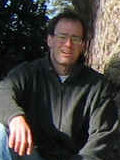
Will Blozan, President, Eastern Native Tree
Society, President, Appalachian Arborists, Inc., ISA Certified Arborist
SO-4032A
http://www.appalachianarborists.com/ Will is a former science
technician with the GSMNP. Will has a widely recognized reputation as a
tree measurer. He has been featured in articles, on TV., and on radio.
Will is a co-author of "Stalking The Forest Monarchs - A Guide To
Measuring Champion Trees". He has climbed and measured the tallest or
among the tallest trees in South Carolina, Georgia, North Carolina,
Tennessee, Pennsylvania, Massachusetts, and New Hampshire. Will Blozan
helped organized and mapped the structure of the Middleton Oak, in South
Carolina, the Sag Branch Tulip - the first two tree to be mapped in
eastern United States. Will organized and directed the Tsuga Search
Project that documented the largest and greatest of the Eastern hemlock
trees found anywhere, many of them hundreds of years old, prior to their
untimely death as the result of infestation by an invasive insect - the
Hemlock Wooly Adelgid. Will Blozan has recently become involved in a
canopy mapping project of some of the giant Sequoia's in Whittaker
Forest in California as part of a National Geographic Project. |
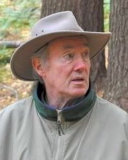
Robert T.
Leverett,
Native Tree Society (ENTS):
Cofounder and executive director.
Friends of Mohawk Trail State Forest:
Cofounder (1993), President, and principal old growth forest ecologist
for this federally recognized non-profit environmental
organization and an officially recognized Friends organization to the
state forests and parks of the Commonwealth of Massachusetts.
Ancient Eastern Forest Conference
Series: Principal architect, and presenter.
Conferences held on eastern old growth forest sites bring
together academics, resource managers, and environmental activists to
share information on eastern old growth and present technical papers.
Conferences held at University of North Carolina; Williams College, MA:
University of Arkansas(2 events): Clarion University of
Pennsylvania: University of Minnesota, Harvard University-Harvard
Forest, Sweet Briar College, VA, and the University of New Hampshire,
Eastern Kentucky University.
Forest Summit Lecture Series:
Cofounder with Professor Gary Beluzo
Sponsored annually by Holyoke Community College, Holyoke,
Massachusetts as a public service.
Some of his publications include:
Stalking the Forest Monarchs-A Guide to Measuring Champion
Trees’ Coauthor of. with Will Blozan on how to
measure champion trees (1997). Included new measurement techniques.
‘Old Growth In The East, A Survey’ Wrote forward and lead essay for Dr. Mary
Davis's publication seminal publication on the old growth sites in the
East, 1993.
‘Re-Wilding the Northeast - A New Wilderness
Paradigm’ A coauthor of the book. Wrote lead chapter on
eastern old growth. Published by University Press of New England.
‘Sierra Club Guide Book to Ancient Forests of
the Northeast’
Coauthor with Bruce Kershner of this 2004
book on old growth sites in the Northeast. Robert Leverett
holds scientific research permits with the Great
Smoky Mountains National Park and the Blue Ridge Parkway, and in the
past, Congaree National Park and has research access to Thomas
Jefferson’s Poplar Forest Estate and James Madison’s Montpelier.
He has worked closely with the Massachusetts Department of Conservation
and Recreation on the development and implementation of the state's
Forest Reserve system and other aspects of forest management. He
is one of two individuals responsible for the old growth
inventory, mapping, and documentation for DCR in Massachusetts.
|
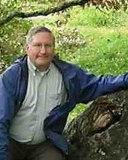 Dr. Lee E. Frelich,
Vice President of The Eastern Native Tree Society,
Dr. Frelich is Director of the University of Minnesota
Center for Hardwood Ecology. He received a Ph.D. in Forest
Ecology from the University of Wisconsin-Madison in 1986.
Frelich teaches courses in Forest Fire Ecology and Landscape
Ecology on St.Paul Campus. He has advised 18 graduate students,
and is a senior member of the Conservation Biology, Natural
Resource Science and Management, Ecology, and Invasive Species
Graduate Programs. Frelich has published numerous papers on
forest ecology and has been listed among the top 1% of all
scientists in the world in the Science Citation Index, Ecology
and Environment Category. He has appeared in the news media 200
times including /The New York Times/, /Newsweek/, /National
Geographic/, and many TV and radio stations. Current research
interests include fire and wind in boreal forests, long-term
dynamics of old-growth hemlock and maple forests, invasive
earthworms in forests, and global warming. Dr. Lee Frelich
is one of the most distinguished forest ecologists in the United
States and the foremost expert on natural forest disturbance
regimes in the forests of the upper Mid-West. He is the author
of "Forest Dynamics and Disturbance Regimes". Lee is often
called on as an expert witness on subjects that span the
spectrum of forest issues from the potential impact of climate
change to what constitutes an old growth ecosystem.
|

Dr. David Stahle, an ENTS co-founder, is
a
Distinguished Professor,, University of Arkansas, Director,
Tree-Ring Laboratory.
Professor of Physical Geography and the Conservation of
Natural Resources. Dr. Stahle's research interests include all
aspects of dendrochronology, particularly climate change and
the proxy evidence for past variation in the El Nino/ Southern
Oscillation and other large scale atmospheric circulations. Dr
Stahle has developed GIS-based predictive models for the
location of ancient forests, and is conducting active research
in the United States, Mexico and Africa. Dr. Stahle's research
is funded by NOAA , NSF, NPS and the USGS and he has published
in a variety of journals including, Science, Nature, Journal of
Climate and Bulletin of the American Meteorological Society. Dr.
Stahle has taught courses in Physical Geography and Conservation
of Natural Resources. Ph.D., Arizona State University,
Geography 1990.
http://www.uark.edu/misc/dendro/
http://www.uark.edu/misc/xtimber |
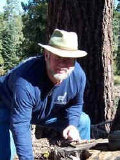
Don Bertolette
is the founder and President of the Western Native Tree
Society. His career started in as a pre-Forestry community
college student working for the BLM as a Forestry Aid (GS-3)
with BLM in Eastern Oregon, and with a few exceptions (as
material coordinator/pipefitter supervisor with Fluor Engineers
and Constructors, in Saudi Arabia) I stayed the course with
federal land management agencies through retirement last year as
a GS-12 program manager, with the National Park Service, Grand
Canyon National Park, AZ. My education started early on pursuing
a Bachelor of Science degree in Forest Resources Management,
which I completed at Humboldt State University in 1983.After
nearly a decade with the USFS, I was encouraged to pursue my
Master of Science degree in Forestry with University of
Massachusetts, at Amherst, where I specialized in Remote Sensing
of Old-growth Forests, and successfully defending thesis in
1993. Returning to the West (Arizona/Alaska), I developed skills
in GIS that eventually led to Fire Area Growth Simulation, to
model wildfire growth. With additional studies at Northern
Arizona in Ecological Restoration, I obtained NEPA compliance
for, and completed Wildfire Hazard Reduction Research project at
Grand Canyon National Park. At my retirement from Grand Canyon,
I was Vegetation Program Manager (Developed Area). Since
retiring in 2007, I’ve continued participation with ENTS/WNTS,
the Cook Inlet Chapter of SAF, and am Alaska’s Big Tree
Coordinator.
|
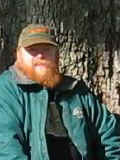
Dr. Robert Van Pelt is one of the foremost
scientists in the world studying and mapping forest canopies and
determining tree volumes. In addition,
Dr.
Van Pelt is an author and the coordinator of the champion tree
program for the state of Washington. He is currently a Adjunct
Professor, Institute for Redwood Ecology, at Humboldt State
University where he is engaged in canopy research in Douglas Fir and
Coast Redwood forests. He gives occasional lectures and lead field
trips for the University, and teach several field classes on Pacific
Northwest old-growth forests and Northwest canopy ecology. He
received his MS in 1991 and PhD in 1995 from the University of
Washington. His main research interests are old-growth ecology,
canopy structure and its control of the understory environment,
spatial patterns in old-growth forests, and tree plant geography.
This life takes me to many of the great forests of the Pacific
Northwest and California. He was part of the National Geographic
Canopy Trek project in the fascinating canopy work in the world’s
tallest hardwood forest in Australia. He spends much of my private
life measuring trees – I maintain a database of tree measurements
from all over the world. He take extensive measurements, sketches
and photos on some of the most remarkable of these trees for tree
portraits. An avid hiker, photographer, woodworker, and big tree
hunter, He is continually on the lookout for new and exciting
trees. Select books include: Van Pelt, R. 2008. Identifying Old
Trees and Forests in Eastern Washington. Washington State Department
of Natural Resources, Olympia, WA. 178 p.; Van Pelt, R. 2007.
Identifying Mature and Old Forests in Western Washington. Washington
State Department of Natural Resources, Olympia, WA 104 p.; and Van
Pelt, R. 2001. Forest Giants of the Pacific Coast. Univ. Washington
Press. 200 p.
http://www.forestgiants.com/
|

Michael W. Taylor,
Vice-President of the Western Native Tree Society, is now the
American Forests champion tree coordinator for California.
Michael W. Taylor is a leading discoverer of champion and
tallest trees - most notably Coast Redwoods. In 2006, Michael
co-discovered the tallest known tree in the world, a coast
redwood (sequoia) now named "Hyperion". He also discovered
"Helios" and "Icarus", the 2nd and 3rd tallest. National
Geographic made a video about the discovery and measuring of
Hyperion. The discovery made headlines. Taylor has discovered
50 coast redwoods over 350 feet tall, and co-discovered
approximately 100 more over 350 feet with Chris Atkins and
Stephen Sillett, who is the first holder of the Kenneth L.
Fisher Chair in Redwood Forest Ecology at Humboldt State
University. Taylor and Sillett have collaborated and measured
remarkable previously unknown redwoods. Their discoveries have
fueled research and public interest in coast redwoods, which are
now a World Heritage Site. Michael is a main character of the
non-fiction book (2007) The Wild Trees. The narrative includes
how Taylor began exploring for tall trees, measuring tallest
trees, and later networking with Pacific coast forest
researchers. |
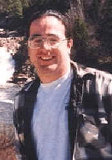
Dr. Don Bragg,
Research Forester, USDA Forest Service Southern Research
Station, Monticello, AR. Dr Bragg serves as editor of the NTS
scientific journal "Bulletin
of the Eastern Native Tree Society." He has engaged in
multiple research projects related to the upland forests of the
Midsouth region. This has included studies on ice damage to pine
plantations in the South, investigation of the Cross Timbers
woodland in western Arkansas, and completion of long-term growth
and yield projects. Much of my work has also concentrated on the
refinement of silvicultural techniques for the development of
old-growth-like attributes in managed stands of the northern
Lake States and the Midsouth (primarily Arkansas). His Ph.D.
(1999) is in Forest Ecology, from Utah State University. He is
a member of the Society of American Foresters, the Ecological
Society of America, the Forest History Society, the Torrey
Botanical Society, the U.S. Chapter of the International
Association of Landscape Ecologists, and the Natural Areas
Association.
http://www.srs.fs.usda.gov/staff/767
http://www.srs.fs.usda.gov/4106/about/Scientists/dbragg/dbragg.htm
Select Publications:
http://www.srs.fs.usda.gov/4159/about/Scientists/dbragg/dbragg_pubs.htm
SRS-RWU-4159 Ancient, Big, and Historical Trees of Arkansas,
Past and Present:
http://www.srs.fs.usda.gov/4159/about/Scientists/dbragg/big%20trees/AR_big_trees.htm&n |

Dale Luthringer, the naturalist and
educational director for Cook Forest State Park, PA, runs the
NTS workshop for tree measuring. He has been the driving force
in the documentation and measurement of the great trees and old
growth forest across western Pennsylvania and other nearby
states.
Dale Luthringer has been the Environmental Education
Specialist at Cook Forest State Park for the past 8 years. He
facilitates interpretive programs and teacher workshops to over
15,000 participants per year. He regularly gives tree measuring
workshops and old growth forest workshops for teachers at the
park. Dale Luthringer serves as host of biennial rendezvous of
NTS at Cook Forest. He His ecological research includes acid
mine reclamation, white-tailed deer populations, West Nile
virus, and most recently the Old Growth Forest. Dale has
quite a varied background. He was a farmer for 9 years, a Marine
Corp sergeant, and a furniture maker. After his 4 years with the
Marines, he moved to the area to attend school. Dale earned an
A.S. in Wildlife Technology from Penn State DuBois and a B.S. in
Applied Ecology from Clarion University. Some of his pubications
include: Old Growth Forests in the Pennsylvania Wilds by Dale
Luthringer
http://www.dcnr.state.pa.us/info/pawilds/0809-twotw.aspx and
Luthringer, Dale J. 2009. Big Trees of Cook Forest. Pennsylvania
Forests, Volume 100, No. 3, Fall 2009.
|
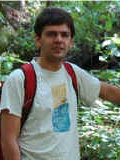
Dr. Neil Pederson, Assistant Research
Professor at Lamont-Dougherty Earth Observatory - Tree Ring Lab,
at Columbia University. Research Interests: My research
interests are centered on trees, ecosystems and old-growth
forests at the intersection of climate change, ecology,
conservation biology, natural history, forest management and
charismatic megaflora. I conduct basic and applied research to
gain information that can help ecologically-based, long-term
management plans. Education: Ph.D. - Columbia University, Dept.
of Earth & Environmental Science. Dr. Pederson created and
maintains the Eastern Old-List - a listing of the oldest trees
in eastern North America:
http://www.ldeo.columbia.edu/~adk/oldlisteast/ CV
http://www.ldeo.columbia.edu/~adk/CV.pdf
Select
Projects: 1) Fire, Climate and Forest Ecology in Mongolia
funded by the National Science Foundation
http://www.ldeo.columbia.edu/~adk/mongoliaFire/ 2) Drought
History of Three Ponds and Blanton Forest Preserves:
Investigation of an East-West Drought Gradient Across Kentucky
funded by the Kentucky State Nature Preserves Commission
http://www.ldeo.columbia.edu/~adk/research/KYdrought/
Selected Publications: 1) McEwan, R. W., J.M. Dyer and N.
Pederson. 2011. Multiple interacting ecosystem drivers: toward
an encompassing hypothesis of oak forest dynamics across eastern
North America. Ecography 34: 244-256 doi:
10.1111/j.1600-0587.2010.06390.x; 2) N. Pederson. 2010.
External Characteristics of Old Trees in the Eastern Deciduous
Forest. Natural Areas Journal 4: 396-407.
pdf |
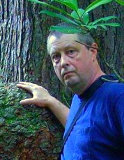
Edward F. Frank
is the webmaster of the NTS website, Administrator of the NTS
BBS, and editor of our monthly magazine the
eNTS Magazine. By training he is a geologist with a MS
in Geology from Mississippi State University. Thesis title:
Aspects of Karst development and Speleogenesis Isla de Mona,
Puerto Rico: An Analogue for Pleistocene Speleogenesis in The
Bahamas. I was a PhD candidate in Geology at the University of
Minnesota. I have peer reviewed published papers in fields
ranging from spelean history, geology, archaeology, vertebrate
paleontology, karst processes and speleogenesis. Some examples:
Journal of Cave and Karst Studies, Vol. 60(2), August 1998.
He am a member of the National Speleological Society and have
been involved in cave exploration ad mapping across the United
states from New Mexico, to Kentucky and Tennessee, to
Pennsylvania, west Virginia, and Virginia. I organized and lead
a speleological expedition to the Dominican Republic in December
1986, and have participated in and organized field work in the
Bahamas and Puerto Rico. he is actively involved in many of the
research projects being conducted by the Native Tree Society. |
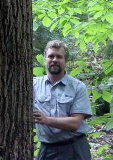 Gary Beluzo is
Professor of Environmental Science at Holyoke Community
College. M.S. Global Ecology (Botany) UMASS Amherst. He
was the Department Chair 1984-1998. Although Gary’s earlier
interest was limnology, he entered a partnership with Bob
Leverett in the fall of 1998 to inventory, characterize, and map
(GPS/GIS) the old growth forests of Massachusetts with a special
permit from the MASS DCR and now also the Great Smoky Mountains
(TN/NC). Through an NSF Grant in 1996, Professor Beluzo
created an Environmental GIS laboratory at HCC and is now
developing an extensive geo-database of old growth forests and
champion trees for Massachusetts . Professor Beluzo is
also the on campus architect of the HCC Forest Summit Lecture
Series and Eastern Native Tree Society Rendezvous. This
event brings together scientists, foresters, environmentalists,
and the public to discuss current Eastern U.S. Forest Issues.
Gary Beluzo is one of two individuals responsible for the old
growth inventory, mapping, and documentation for DCR in
Massachusetts. Robert Leverett is the other.
|
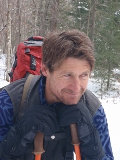 John Davis "John
Davis, a 47-year-old “tri-athlete meets John Muir”, also is
a founder of Wildlands Network, past editor of the widely
respected Wild Earth magazine, writer and naturalist. Throughout
his career as conservation leader with other renowned
conservation organizations, this Adirondack native with an
indomitable passion for nature has supported continental-size
wildlife corridors called Wildways."
http://www.wildlandsnetwork.org/node/141 In 2011 he
undertook a 7,000 mile journey along the "eastern wildway" via
many human powered means including canoe, hiking, bicycling, and
kayak among others as part of the
Wildlands
Network's TrekEast Project. He is a past Director of
Conservation of the Adirondack Council The Council, which has
offices in Elizabethtown and Albany, New York, works to protect
the ecological integrity and wilderness character of the park.
Davis's responsibilities include serving as the primary point of
contact for the Council with the New York state legislature.
For the previous two years he served as land steward for the
Eddy Foundation, which purchases and preserves wildlands in the
eastern Adirondacks of northern New York. With the foundation,
he conceived and is helping to create and protect a wildlife
corridor linking New York’s Adirondack Mountains with the
Champlain Valley, a habitat linkage called the Split Rock
Wildway. He owns Hemlock Rock Wildlife Sanctuary, a fifty-acre
preserve within the Wildway.
|

Bart Bouricius
has worked as an arborist (Bart's Tree Service)
since 1973 and still does part time, but his primary work is as
an installer of canopy walkway systems for Canopy Construction
Associates, an organization he founded in 1991. The group is
an association of arborists, builders and scientists. The
organization
www.canopyaccess.com,
was originally established to provide access to biologists for
studying life in the forest canopy, but now also constructs
projects for Eco-tourism companies as well. They have
constructed over 15 systems in Belize, Borneo, Ecuador, Peru,
Florida, North Carolina, New York, Tennessee, and
Massachusetts. Bart came to this occupation as a
conservationist and naturalist with a hope that ordinary people
experiencing the canopy of primary forest from an altitude would
improve their attitude regarding preservation of forests around
the world. He frequently gives presentations on Tropical
Rainforest Ecology and Arthropods, primarily Arachnids and ants
to Colleges, K-12 schools and museums. Bart is a Research
Associate at the Hampshire College School of Natural Science and
is active in trying to preserve forests and other natural
habitats in Massachusetts. He has helped organize 2 canopy
research conferences in Florida in the early 1990's.
Publications: Bart Bouricius has published articles on canopy
access techniques, one on canopy bridge safety calculations for
construction, and an article on the life history of Amblypygids
(tailless whip scorpions).
|
We have several members who are the coordinators of state champion
tree programs: Scott Wade is the big tree coordinator for
Pennsylvania, Don Bertolette is the coordinator for Alaska, Michael
Taylor is the big tree coordinator for California, plus several
other coordinators are also members.
In addition to the active members listed above we have many more
members with PhD's in various aspects of forestry. We have members
with a variety of other educational backgrounds. We have people who
are entomologists, meteorologists, geologists, artists, musicians,
medical professionals, foresters, arborists, and people with no
special training who just have an interest in trees and forests.
All make valuable contributions to the overall efforts.
© Copyright 2002-2011
Eastern Native Tree Society
|
 We
have added unprecedented tree dimension accuracy and have contributed
enhanced site descriptions for many forest icons to include superb
forest sites like the Great Smoky Mountains National Park, Cook Forest
State Park, PA, Zoar Valley, NY, and Mohawk Trail State Forest, MA. We
have a far better grasp of eastern species dimensional maximums than any
other individuals or groups anywhere and we're far from done. Our recent
thrust into the southern world of the live oak promises to shine the
spotlight on a species that has been way under-represented in the big
tree annals.
We
have added unprecedented tree dimension accuracy and have contributed
enhanced site descriptions for many forest icons to include superb
forest sites like the Great Smoky Mountains National Park, Cook Forest
State Park, PA, Zoar Valley, NY, and Mohawk Trail State Forest, MA. We
have a far better grasp of eastern species dimensional maximums than any
other individuals or groups anywhere and we're far from done. Our recent
thrust into the southern world of the live oak promises to shine the
spotlight on a species that has been way under-represented in the big
tree annals.











